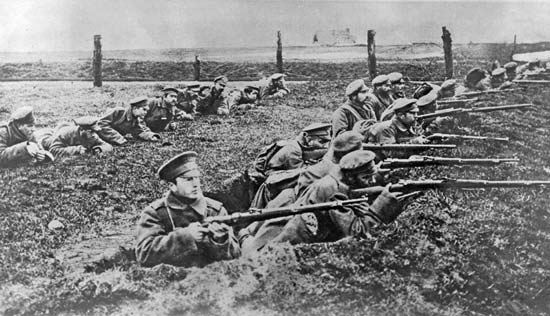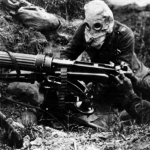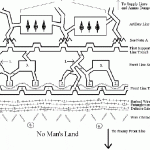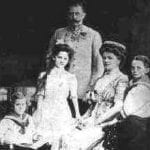The following article is an excerpt from H.W Crocker III’s The Yanks Are Coming! A Military History of the United States in World War I. It is available for order now from Amazon and Barnes & Noble.
When Sir Edward Grey, Britain’s foreign secretary, received word that Germany had declared war on France, he was watching the street lamps being lit below his office window. He remarked to a friend, “The lamps are going out all over Europe; we shall not see them lit again in our lifetime.” In the United States, the lamps would continue to burn brightly, and they would be lit again in Europe, but only after the New World came to redress the balance in the Old.
To reach France, Germany overran Belgium. But Belgium was more than overrun, it was terrorized. While propagandists exaggerated German atrocities in Belgium, the reality was striking enough. The Germans razed Belgian villages and executed villagers—men, women, and children, eventually numbering into the thousands—en masse. Priests, as authority figures and potential symbols of resistance, were particular targets. If that outraged some, even more were outraged by the burning and looting of the famous university town of Louvain. Over the course of five days, beginning on 25 August 1914, the Germans pillaged the city. Its celebrated library, with its collection of medieval manuscripts, was put to the torch; its townspeople were driven out as refugees.
“NECESSITY KNOWS NO LAW”
The Germans, however, believed they were fighting a war for civilization—for German Kultur against Latin decadence and Slavic barbarism. The highly educated German general staff had readily adopted social Darwinist ideas and applied them to the conduct of war—for example, in General Friedrich von Bernhardi’s book Germany and the Next War (published in 1911). He called war “a biological necessity” in the struggle for existence, adding that war “is not merely a necessary element in the life of nations, but an indispensable factor of culture, in which a true civilized nation finds the highest expression of strength and vitality.”
The first problem was the Belgians. They refused to capitulate, blunting the initial German assault, inflicting heavy casualties, and withdrawing only when the German army’s determination to stay on schedule at any price was backed by heavy guns. Despite gallant Belgian resistance, the German juggernaut bombarded its way through the country: the Germans took Brussels on 20 August and sped to France.
The French, meanwhile, in traditional finery—blue coats, red trousers, officers in white gloves, all of which gave courage to their hearts if not concealment from the enemy—stormed into Lorraine and the forest of the Ardennes to be met by Germans in field grey manning entrenched machine guns and artillery. The results were what might be expected: a grand sacrifice pour la patrie. In the single month of August, 10 percent of the French officer corps fell as casualties.
As the Germans made their great wide sweep through Belgium and into France, they stubbed their toe on the British Expeditionary Force (BEF) on the far left of the French line at the Belgian city of Mons. At the war’s commencement, Kaiser Wilhelm had ordered the BEF destroyed, dismissing it as a “contemptibly small army.” Small it was, at least in the context of the Great War. About eighty thousand men of the BEF were at the Battle of Mons on 23 August. Contemptible it was not, as the British regulars stopped the German advance before being ordered to withdraw against an enemy that had twice their number of men and guns. The Battle of Mons was the sort of thing the British specialize in—heroic withdrawals, which if they do not win wars at least exemplify the bulldog spirit. The Battle of Mons inspired a legend about the Angels of Mons, where St. George and the Bowmen of Agincourt were said to have descended from the heavens to help the British.
In the East, Austria had to divert troops from its Serbian offensive to fend off the Russians, and a worried Moltke reinforced East Prussia. Before those reinforcements arrived, the German Eighth Army, under Generals Paul von Hindenburg (called out of retirement to meet the crisis) and Erich von Ludendorff, had knocked the wheels off the Russian steamroller, destroying its Second Army at the Battle of Tannenberg (26–30 August). Russian losses (170,000 casualties, more than 90,000 of them surrendering) were greater in size than the entire German Eighth Army, which suffered 12,000 casualties. The stolid, determined Hindenburg, the embodiment of the tough, dutiful virtues of the Prussian aristocracy, became a hero, as did the emotionally tempestuous and not quite as well-born Ludendorff. Ludendorff, brilliant and aggressive, had already made his name and been awarded the Blue Max for his conduct in Belgium, where he had taken a sword and pounded on the gates of the citadel at Liège, and accepted the surrender of hundreds of Belgian soldiers.
Though impeded in the West and outnumbered in the East, the Germans were crushing their enemies, proving themselves the best soldiers in Europe. The Austrians, however, were taking a pounding. The Austrian Field Marshal Conrad von Hötzendorff was as aggressive as Ludendorff but with an army incapable of carrying out his ambitious plans. By the end of 1914, the Habsburg Empire had suffered an astonishing number of casualties—more than six hundred thousand men—and was in constant need of German support. Many German officers felt that being allied to the Habsburg Empire was, in the famous phrase, like being “shackled to a corpse.”
While the Austrians were struggling, the Germans had blown through Belgium and now appeared almost unstoppable: the French government felt compelled to evacuate Paris on 2 September. One very important Frenchman, however, retained his savoir faire. The French commander General Joseph Joffre—walrus-moustached, imposing, imperturbable—rallied his army for what became “the miracle of the Marne.” French troops, still in their prideful blue coats and pantaloons rouge, came ferried to the front in an armada of French taxis pressed into emergency service. The French hit the exhausted German First and Second Armies, surrounding them on three sides and bringing them to a shuddering halt; Moltke had a nervous breakdown, fearing he had stumbled into a disaster (though the Germans were able to extricate themselves); and the Schlieffen Plan fell to pieces. Two million men fought at the First Battle of the Marne (5–12 September 1914), and the consequence of this epic battle was not just an Anglo-French parrying of the German slash and thrust, it was a stalemated war of trenches from which there appeared no escape.
STALEMATE
When Confederate veteran John Singleton Mosby was asked to comment on the trench warfare in Europe, he said that Robert E. Lee or Stonewall Jackson would have found a way around. “As it is, the forces are just killing. The object of war is not to kill. It is to disable the military power.” But with all due respect to Mosby, Jackson, and Lee, there was no easy way around.
If you followed the war through American newspapers, you were getting a quick refresher course in the geography of Europe and Asia as generals struggled to find a way to break the deadlock on the Western Front. In 1914, there was the “race to the sea,” with both sides attempting to outflank each other in northwestern France and southwestern Belgium. When the belligerents’ confronting trenches stretched from the English Channel to Switzerland, there were attempts to turn more distant strategic flanks, as in the Gallipoli Campaign against the Turks in 1915. Of massive battles there was no shortage, but by sticking pins in a map you could see that huge expenditures of men often moved the armies hardly at all, or moved them in ways that seemed marginal to any ultimate victory.
French fought the First Battle of Ypres (19 October to 22 November 1914), where each side tried to gain the offensive in southwestern Belgium. The resulting combined casualties were nearly three hundred thousand men. While the Entente Powers blocked German attempts to renew the rightward thrust of the Schlieffen Plan, the battle also marked the end of the British regulars, the “Old Contemptibles.” They had fought brilliantly throughout, starting at the Battle of Mons, but were worn to the quick by casualties.
French’s last battle with the BEF was the Battle of Loos (25 September to 14 October 1915) in northwestern France. Outnumbering the Germans in front of him, he thought he could blast his way through. The result was fifty thousand British casualties (including Rudyard Kipling’s son, John, missing, presumed dead) and half that many German. The British tried using chlorine gas, already employed by the Germans, to overcome the stasis of the trenches. Instead, it blew back over the British, who had to charge through their own poison mist. Lack of artillery support and replacements for exhausted infantry units meant that while the British captured Loos, they could go no farther and were forced to withdraw.
To the relief of the American newspaper reader, French’s replacement was the much less confusingly named Field Marshal Sir Douglas Haig. Haig had the additional advantage of confirming American stereotypes that British commanding officers were all bluff, wellturned-out, well-mannered, white-moustached British aristocrats (as indeed many of them were). Haig held command of the British forces through the end of the war, so it was he who would eventually greet General John J. Pershing, commander of the American Expeditionary Forces, in late July 1917, about a month after Pershing arrived in France.
On the French side, American newspaper readers would have been familiar with General Joffre—who actually came to America in April 1917 on a goodwill mission after Congress’s declaration of war—because Americans still remembered him as the hero who had saved France at the Battle of the Marne. Joffre, like Sir John French, had believed the Germans could be defeated on the Western Front if the Western Allies applied sufficient artillery and men at the crucial point. Finding that crucial point, however, was proving immensely costly; it was not easily discovered.
Another familiar French general was Joffre’s fellow hero of the Marne, Ferdinand Foch. A renowned writer and lecturer on military strategy and allegedly the finest military mind of his generation, he was sixty-two years old in August 1914, and up to that point he had never seen combat. Nor had he served abroad, in the training ground of France’s empire. But those disadvantages paled to insignificance compared with his detailed understanding of the German army, which he had always regarded as the main enemy. The key problem for Foch was how to overcome German military superiority in numbers, equipment, and training. He found part of the answer in a patriotic assertion of the French spirit. Foch’s own spirit was one of the legends of the Battle of the Marne. Commanding the Ninth Army, his headquarters exposed to the enemy, he famously proclaimed, “My center is giving way, my right is in retreat. Situation excellent. I attack.”
Foch and Haig were commanders at the Battle of the Somme, which lasted from July through November 1916. To the newspaper reader, it was doubtless an awful and awe-inspiring event, with more than a million combined casualties between the Germans and the Western Allies. To the soldiers in the trenches, it was a test of fire and endurance that most of them met with incredible but matter-offact fortitude, even with “Death grinning at you from all around and hellish 5.9 inch shells shrieking through the air and shrapnel dealing death all round,” as one Australian captain wrote to his parents. “I don’t know how long I stood it without breaking.” He was “very thankful to get my wound as it got me out of the firing line for a rest.” Rest, aside from the permanent kind, was hard to come by.
The Battle of the Somme was an Anglo-French offensive to break the German line in northwestern France through a mighty assault; the hope was to force a gap that would allow cavalry (and tanks, which made their first appearance here) to plunge through, starting a war of movement that would end the deadlock of the trenches. The British lost nearly sixty thousand casualties on the first day of the Battle of the Somme trying to make this happen, with an opening artillery barrage so earth-shattering it was heard across the English Channel. But in four and a half months of battle, there never was a major gap to exploit. The Somme was primarily a British battle, and Haig kept thinking that a tenaciously pursued offensive must eventually “overthrow” the enemy. His resolute confidence was not matched by his political minders in London, who wondered how such losses could be justified, even as part of a war of attrition, for such minimal territorial gains. German lines had been pushed back six or seven miles at most.
The Battle of the Somme was preceded and outlasted by another battle equally enormous in cost, the Battle of Verdun, fought between the Germans and the French from February to December 1916. Erich von Falkenhayn, Helmuth von Moltke’s successor as chief of the German general staff (since November 1914), recognized that attacks against fortified lines were generally futile, but nevertheless concluded that a decisive blow could be made against Verdun, a heavily fortified French city of the northeast, which projected into a pocket of the German front line. The French, out of pride and because it guarded a path to Paris, could not abandon it, and for that reason Falkenhayn believed he could turn Verdun, ringed on three sides by the Germans, into a killing ground for the French army, a massive battle of attrition fought by artillery. The Germans opened with a barrage that lasted nine hours.
General Philippe Pétain was given command of the citadel of Verdun. He would not relinquish it. Pétain, who believed in superior firepower as the way to win battles, worked hard to keep Verdun well supplied, tried to match German artillery shells with his own, and rotated his men to lessen the nerve-shattering effects of perpetual bombardment. The Germans, commanded in the field by Crown Prince Wilhelm, inflicted enormous numbers of casualties, but ended the battle suffering almost as badly as the French; and because Verdun was held, it was the French who claimed the victory. Frenchmen, and Americans who read about the battle, would remember the order given in June 1916 by Pétain’s subordinate, General Robert Nivelle, commanding the French Second Army at Verdun: “They shall not pass”—and the Germans, by battle’s end, had not. By the time the Americans arrived in France, Pétain was commander in chief of the French army, and Hindenburg had replaced Falkenhayn as chief of the German general staff.
This article is part of our extensive collection of articles on the Great War. Click here to see our comprehensive article on World War 1.
 |
 |
 |
This article is from the book The Yanks Are Coming! A Military HIstory of the United States in World War I © 2014 by H.W Crocker III. Please use this data for any reference citations. To order this book, please visit its online sales page at Amazon or Barnes & Noble.
You can also buy the book by clicking on the buttons to the left.
Cite This Article
"The Start of World War 1: The Outbreak of the Great War" History on the Net© 2000-2024, Salem Media.
April 20, 2024 <https://www.historyonthenet.com/the-start-of-world-war-1-the-outbreak-of-the-great-war>
More Citation Information.









